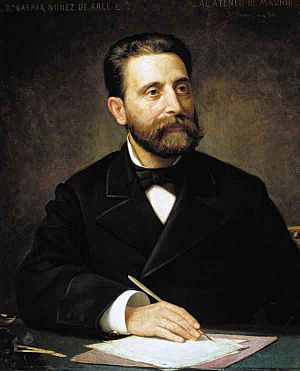Gaspar Núñez de Arce facts for kids
Quick facts for kids
Gaspar Núñez de Arce
|
|
|---|---|

Portrait by Ignacio Suárez Llanos
|
|
| Born | 4 August 1834 Valladolid, Spain |
| Died | 9 June 1903 (aged 68) Madrid, Spain |
| Occupation | Politician, poet, playwright |
| Seat T of the Real Academia Española | |
| In office 21 May 1876 – 9 June 1903 |
|
| Preceded by | Antonio de los Ríos Rosas |
| Succeeded by | Eduardo de Hinojosa y Naveros |
Gaspar Núñez de Arce (born in 1834, died in 1903) was a famous Spanish poet, playwright (someone who writes plays), and politician. He was even nominated for the important Nobel Prize in Literature five times!
Contents
About Gaspar Núñez de Arce
Gaspar Núñez de Arce was born in Valladolid, Spain. His family wanted him to become a priest. But Gaspar was more interested in writing and literature.
When he was just 15 years old, he wrote a play called Amor y Orgullo (Love and Pride). This play was performed in Toledo in 1849. His father, who worked for the post office, was not happy about Gaspar's choice.
Moving to Madrid
Gaspar decided not to join the church. Instead, he moved to Madrid, the capital city. There, he started working for a newspaper called El Observador. This newspaper supported liberal ideas, which meant they wanted more freedom and changes in society.
Later, he started his own newspaper, El Bachiller Honduras. In this paper, he wrote about his ideas for a more united and liberal Spain. People started to notice his writing and his political views.
Entering Politics
Because of his strong opinions and writing, Gaspar became involved in politics. He was made the governor of Logroño. In 1865, he was chosen to represent Valladolid in the Spanish parliament.
He was even put in prison in Cáceres for speaking out against the government at the time. When Queen Isabella II was removed from power, Gaspar helped write an important message for the new government.
For a few years, he stepped back from politics. But when the monarchy was brought back, he joined a political party led by Sagasta. Under Sagasta, Gaspar became a minister several times. He was in charge of different areas like the colonies, the interior, money, and education.
However, his health was not good, so he had to leave his government jobs in 1890. He never took office again after that. In 1874, he was elected to the Spanish Academy, a very important group for language and literature. In 1886, he became a senator for life. He passed away in Madrid in 1903.
His Famous Writings
Gaspar Núñez de Arce first became known for his plays. He wrote many plays over about 25 years. Some of his plays include ¿Quién es el autor? (Who is the Author?) and El haz de leña (The Bundle of Firewood).
Poetry and Themes
Even though he wrote plays, Gaspar was even better known for his poems. His most famous collection of poems is Gritos del combate (Cries of Combat), published in 1875. In these poems, he encouraged people in Spain to stop fighting among themselves. He wanted them to work together to save their country.
He also wrote many other important poems. These included philosophical poems (about big ideas), elegiac poems (sad poems, often about loss), and symbolic poems (poems with hidden meanings). Some of these are Raimundo Lulio, Última lamentación de Lord Byron (Lord Byron's Last Lament), and La visión de Fray Martín (The Vision of Friar Martin).
His later works, like La Pesca (The Fishing) and La Maruja, showed his skill in describing everyday life. He also wrote Poemas cortos (Short Poems) and ¡Sursum corda! (Lift Up Your Hearts!).
Gaspar Núñez de Arce was known for his clear way of seeing things, his honesty, and his excellent writing style. He was a master of powerful language and patriotic messages, especially in Gritos del combate.
Images for kids
-
Bust of Gaspar Núñez de Arce in Valladolid.
See also
 In Spanish: Gaspar Núñez de Arce para niños
In Spanish: Gaspar Núñez de Arce para niños


